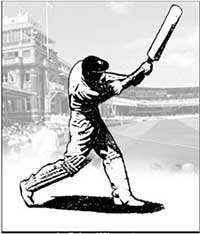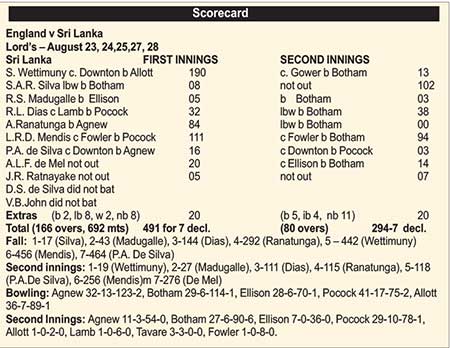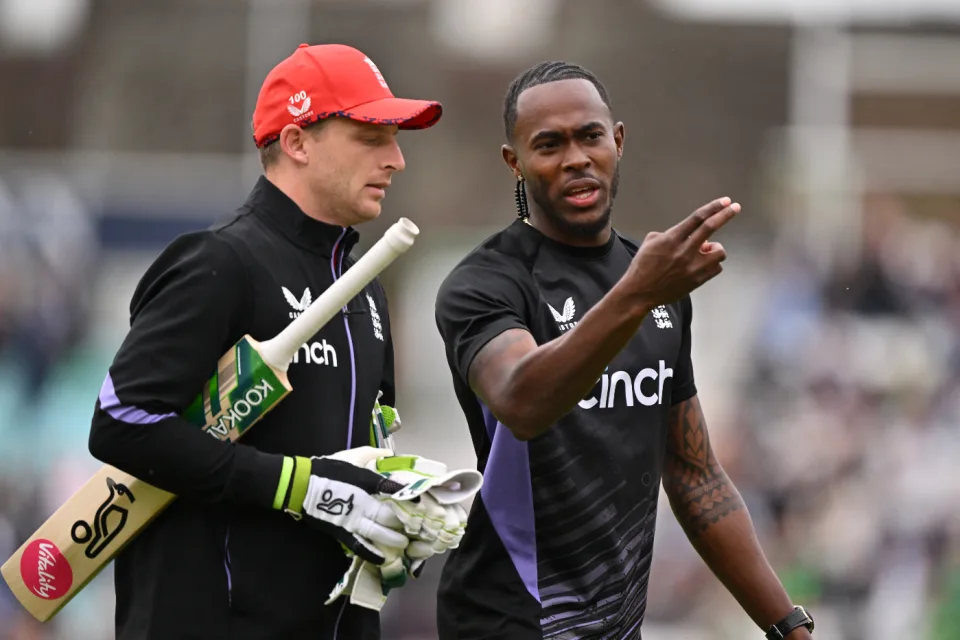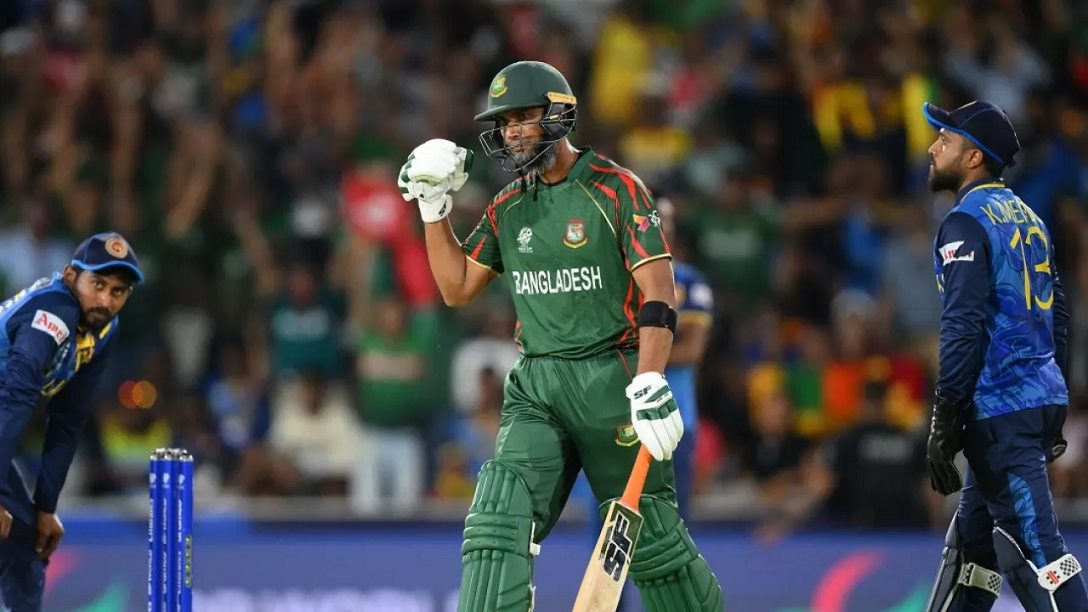Sports
A champagne exit from Lord’s

36th Anniversary of Sri Lanka’s first ever Test match at Lord’s – Part 3
by Rohan Wijeyaratna
The story of this match will serve as a testament not only to the abilities of the 1984 Sri Lankan team, but also to the long cricketing tradition established through the commitment of many generations of past Ceylon cricketers, the country’s wonderful nurseries – the schools, the indefatigable coaches and the clubs that dot the island. All of them played an unseen hand in moulding the Sri Lankan sporting pedigree; an outpouring of which was seen on the first two days at Lord’s. Even though it appeared at the start that there would be only one winner and the game would be one-sided, by the end of day two many were of the view that the most agreeable cricket they witnessed during the entire summer was played on the first two days of this Test at Lord’s and the more deserving side was now on the ascendancy. Denis Compton when I met him at the end of day two put things in perspective. “You chaps today taught us how to bat” he said with disarming candour. There could have been no greater praise, coming from probably England’s finest post war batsman. Others of note – including Tom Graveney expressed similar sentiments. These were indeed heady days for all those who were from the Sri Lankan camp, be they players or spectators alike.
End of two epic innings
There was greater purpose and hurry seen in the Sri Lankan approach when play resumed on Day three. Mendis heaved at anything and everything, while Wettimuny was happy, playing away from his body and relying on his previous day’s form and eye. Something had to give, and it did. Wettimuny forcing Allott on the off from where he stood, managed to deflect a catch behind. That announced the end of an epic feat of endurance which lasted altogether, 642 minutes. It was till then, the longest innings ever in a Test match at Lord’s, and served as the cornerstone upon which the entire innings was built. Shortly thereafter, Mendis heaved at Pocock and holed out to Fowler at long-on. With each of those exits, the crowd rose, as a mark of their appreciation of two magnificently contrasting styles of play which lit up Lord’s in the two preceding days. The applause was long and sustained.

The Sri Lankan intention now appeared plain as pikestaff. De Mel being no mug with the bat, dealt some mighty blows while little Aravinda on his Test debut produced a stroke filled short burst before Mendis declared at 491 for 7. It was the highest ever score by a team playing their maiden Test in England. The closure left Sri Lanka 20 minutes of bowling before lunch.
Posterity might have been better served had the Lankans registered 500 in their very first Test outing at Lord’s, but the decision to close was not without an attacking intent. England were low in form and down in spirit, and to attack them with the new ball on either side of lunch, would give the Lankans their best chance of grabbing some early wickets. Or so they thought.
England’s first requirement was making 292 to avoid the embarrassment of a follow-on. After Fowler had escaped a near catch in the gully to the very first ball from De Mel, Vinothen John bowled a lot of tripe from the other end. It was embarrassing to watch a string of full tosses being delivered at a time when the calling was to put the batsmen under pressure. At lunch, England profiting from this unexpected windfall, were 32 for 0, after 5 overs of rapid batting. With ‘DS’ not making an appearance due to an ankle injury, bleak times portended for the Lankans.
Wretchedly out of form ….
Shortly after resumption, Fowler departed, slicing a catch to second slip. That heralded the most extraordinary passage of play in the match. Vinothen John had by now settled down while De Mel kept steaming in, giving all he got. But they both were far from menacing. The third seamer Ratnayake was largely innocuous, while D.S. de Silva making his appearance only after lunch, bowled his stock-in- trade top spinners nursing a sprained ankle. Against an attack so debilitated, Tavare and Broad went into near slumber. What followed was perhaps the most forgettable passage of play seen in a Lord’s Test for a long time. In 27 dreary overs between lunch and tea, England advanced by 49 runs, with Broad making 19 of them. Together with Tavare, the pair prodded and pushed with infuriating ordinariness, while making the Sri Lankan bowlers seem twice as threatening as they actually were. The batsmen were so out of touch, they allowed ample time and opportunity for a hopelessly ill tuned Sri Lankan attack to find its feet and some rhythm. Tavare having batted toothlessly for 20 overs, advanced to 12 by tea and when he finally went shortly after resumption for 14, he left behind the memory of a man who was so wretchedly out of form, he could hardly hit the ball outside the square.
Woodcock said it all….
 Broad not to be outdone was similarly comatose. While surviving two close lbw decisions from a tireless De Mel, he was twice dropped into the bargain. Gower the new man in, was only marginally better. By close of play 29 overs after tea, the pair had added only 58 runs more to England’s teatime score. The crowd expressed their disapproval unreservedly with some heavy barracking rarely heard at Lord’s. The two sessions since lunch had produced only 107 runs against an attack that was out of fitness and out of form. England were 139 for 2 by the close, with only 105 runs coming off their last 56 overs. John Woodcock writing in the ‘Daily Telegraph’ said “No self-respecting club side would have been content with the way England batted”. And that said it all.
Broad not to be outdone was similarly comatose. While surviving two close lbw decisions from a tireless De Mel, he was twice dropped into the bargain. Gower the new man in, was only marginally better. By close of play 29 overs after tea, the pair had added only 58 runs more to England’s teatime score. The crowd expressed their disapproval unreservedly with some heavy barracking rarely heard at Lord’s. The two sessions since lunch had produced only 107 runs against an attack that was out of fitness and out of form. England were 139 for 2 by the close, with only 105 runs coming off their last 56 overs. John Woodcock writing in the ‘Daily Telegraph’ said “No self-respecting club side would have been content with the way England batted”. And that said it all.
England had the whole of the rest day to digest all the scorn heaped upon them in all forms of the media and bar room conversations. And if one thought there would be a reformed approach to entertain the sparse crowd on Monday, they were mistaken. In fact, by the end of the 4th day, it was generally felt that those who had stayed away from the cricket had been wise; they hadn’t missed much at all.
Lacked imagination
When play resumed on day four Broad and Gower played as though their intention was to bat out the entire day; never mind the prevailing crowd sentiment. England made 71 in the morning session for the loss of Broad shortly before lunch. When De Mel removed Gower with the second new ball shortly after lunch and Botham soon followed, England were 218 for five; still some distance away from avoiding the follow on.
England averted that ignominy through a Lamb – Ellison partnership which realised 87 priceless runs together. Lamb grassed by the keeper when on 36, went on to complete his 4th Test hundred of the summer and when Ellison went for 41, the tireless De Mel accounted for both Downton and Allott in successive balls. With the exit of Pocock and then Lamb off the last ball of the day England were all out for 370, and were trailing Sri Lanka by 121 runs with one more day to go.
 Had England the imagination or desire to give themselves the slightest sniff at a possible chance of victory, they might have rotated the strike and pushed up the run rate, allowing themselves the opportunity to declare sometime after the follow on was averted. But Gower ‘s intransigence and lack of enterprise had been a feature throughout the match. Accordingly, Sri Lanka went into the fifth day, knowing full well the game would only be one of academic interest. Allott pulling a muscle left the proceedings after only one over, while Agnew’s front foot was eternally at odds with the popping crease. This meant that Pocock had to manfully bear the brunt of the attack, along with Botham who was finally reduced to bowling off spin to men adept at playing them in their sleep. That he captured six of the seven wickets to fall may not fully reflect the merit of his performance, although initially, he found some rhythm and swing and snaked a few past the defense of some of the early batsmen. During this effort, Botham surpassed both Fred Trueman and Lance Gibbs’ Test wicket hauls and became the third in line, behind Dennis Lillee and Bob Willis in the all time highest wicket takers’ list at the time. With the 80th over bowled, Sri Lanka declared, to bring to a close a game which was meandering without purpose. It was an ending the tired Englishmen embraced with open arms and a huge sigh of relief.
Had England the imagination or desire to give themselves the slightest sniff at a possible chance of victory, they might have rotated the strike and pushed up the run rate, allowing themselves the opportunity to declare sometime after the follow on was averted. But Gower ‘s intransigence and lack of enterprise had been a feature throughout the match. Accordingly, Sri Lanka went into the fifth day, knowing full well the game would only be one of academic interest. Allott pulling a muscle left the proceedings after only one over, while Agnew’s front foot was eternally at odds with the popping crease. This meant that Pocock had to manfully bear the brunt of the attack, along with Botham who was finally reduced to bowling off spin to men adept at playing them in their sleep. That he captured six of the seven wickets to fall may not fully reflect the merit of his performance, although initially, he found some rhythm and swing and snaked a few past the defense of some of the early batsmen. During this effort, Botham surpassed both Fred Trueman and Lance Gibbs’ Test wicket hauls and became the third in line, behind Dennis Lillee and Bob Willis in the all time highest wicket takers’ list at the time. With the 80th over bowled, Sri Lanka declared, to bring to a close a game which was meandering without purpose. It was an ending the tired Englishmen embraced with open arms and a huge sigh of relief.
Near twin centuries
But that ending came not before another show-piece effort from Mendis who came within a whisker of making twin centuries in his debut Test at Lord’s. Had he done so he would have joined the famous George Headley as only the second in the game’s history to do so. Mendis biffed the bowling with such gay abandon, he made 94 in 97 balls in just over two hours of batting, while reducing Botham to bowling off spin off just two paces, as the effort of a run up wasn’t worth it. Apart from Mendis, the white-helmeted Amal Silva contributed to the score with an unbeaten 102. It was his maiden first class hundred and in only his second Test match.
Unprecedented publicity
No one would deny Sri Lanka’s magnificent showing at Lord’s added considerably to their rising cricketing stock. In fact, no amount of Ambassadors or Politicians could have matched or done more to get their country such creditworthy mention in every single major English newspaper and every single BBC World Service news bulletin for the better part of a week. Had they a more penetrative attack and had their fielding been consistently sharper, the Lankans might have pulled off an improbable win and added to England’s woeful record of losing every single Test match that summer. Though drawn, England were at the receiving end for most of the match and deserved the sobriquet of possibly, the weakest Test team among the seven Test playing nations at the time. While it was an unforgettable Test match for the Sri Lankans, for England the experience was a bolt out of the blue and brought down the curtain on a most forgettable summer.
Sports
England face Australia in the battle of champions

The first truly heavyweight clash of this expanded T20 World Cup format comes freighted with both history and subplots. A rematch of the 2010 World T20 final at Kensington Oval, the match pits Jos Buttler’s defending champions – who are aiming to become the first team to retain the trophy – against the Australian winning machine, victors at the 2021 edition and current world title-holders in Test and ODI cricket. And that’s before you throw in the Ashes for afters.
Already there is added pressure on England, after the rain in Bridgetown led to a share of the points in their opener against Scotland (and that having conceded 90 runs from 10 overs without taking a wicket in a tepid bowling display). Lose to their oldest rivals and it will leave their Super 8 prospects open to being waylaid by the perils of net run-rate calculations, or worse.
The Scotland match was the third abandonment in five suffered by England, after a rain-affected home series against Pakistan, which has clearly hampered their readiness for this campaign after almost six months without playing T20 together. It does not take much for a side to click in this format – and England looked in decent shape when they did get on the field against Pakistan – but Buttler will be anxious for things to go their way on Saturday, if only to avoid further questions referencing the team’s disastrous ODI World Cup defence last year.
Australia, under the laidback leadership of Mitchell Marsh would love nothing more than to add to the English sense of jeopardy – having helped bundle them out of the tournament in India on the way to taking the crown. Their head to head record is less impressive in T20 however, with England having won six of the last seven completed encounters, as well as that 2010 final.
Despite a wobble with the bat, Australia avoided mishap against Oman earlier in the week, the experience of David Warner and Marcus Stoinis shining through in difficult batting conditions. Surfaces in the Caribbean – not to mention those games staged in the USA – have already had teams scratching their heads; rather than the “slug-fest” England had prepared for, following a high-scoring tour of the Caribbean in December, it looks as if boxing smart may be the way to go.
Speaking of Warner, this could be the last time he faces up against England in national colours – and another match-winning contribution would likely reduce the chances of them meeting again in the knockouts. On the other side of the card is Jofra Archer, fresh from an emotional maiden outing at Kensington Oval and ready to take on Australia for the first time in any format since 2020. Can Mark Wood fire up England’s campaign, as he did during last summer’s Ashes? Will Pat Cummins be back to harass the old enemy once again? Seconds out, it’s almost time to rumble.
Cummins is set to return after being rested for the Oman game, which saw Mitchell Starc leave the field with cramp. Starc is understood to be fine and could keep his place – which would likely see Nathan Ellis miss out. Marsh is still not fit to bowl, with Australia likely to continue with the allrounder combination of Stoinis and Maxwell to give them cover.
Australia (probable XI): David Warner, Travis Head, Mitchell Marsh (capt), Glenn Maxwell, Marcus Stoinis, Josh Inglis (wk), Tim David, Pat Cummins, Nathan Ellis/Mitchell Starc, Adam Zampa, Josh Hazlewood
The one change England may consider is Reece Topley coming in for Wood, with the expectation that there will be some rotation among the seamers through the course of the tournament.
England (probable XI): Phil Salt, Jos Buttler (capt & wk), Will Jacks, Jonny Bairstow, Harry Brook, Liam Livingstone, Moeen Ali, Chris Jordan, Jofra Archer, Adil Rashid, Reece Topley/Mark Wood
[Cricinfo]
Sports
South Africa up against their bogey team in batter-unfriendly New York

Once is coincidence, twice is a clue, and three times is proof.
To paraphrase Agatha Christie, that is the narrative around South Africa’s meeting with Netherlands at this T20 World Cup.
The Dutch beat South Africa at the 2022 tournament and ended their semi-final hopes in a match where South Africa appeared to be sleep walking, and then beat them again at the 2023 ODI World Cup, where they exposed South Africa’s vulnerability in the chase. If they to do the treble, not only will Netherlands take the lead in Group D, but they will offer conclusive evidence of the threat they pose to Full Members, especially South Africa.
Of course, it will take some doing after South Africa’s opening performance against Sri Lanka, where they reduced their opposition to their lowest T20I total and chased it down in fairly straightforward fashion thanks to the most stable middle-order of their white-ball era. In Aiden Markram, Tristan Stubbs, Heinrich Klaasen and David Miller, South Africa have bankers and big-hitters and, for this match, they also have the advantage of experience. They’ve already played at Eisenhower Park, and have first-hand knowledge that run-scoring doesn’t come easily;Klassen said they are prepared to use their “cricket brains” and play “smarter cricket”.
But the conditions could be good news for Netherlands, who are not naturally a line-up of big hitters and build their innings on a foundation of turning ones into twos. In other words, they tend to take a slightly more conservative approach to batting, which may work well here, but they’ll be wary of the uneven bounce of the surface and will have to come up with plans to counterattack especially against South Africa’s seamers. Their own bowlers were exemplary in Dallas and will look to build on that performance against a line-up that will likely be more proactive than Nepal’s, but who they have managed to keep quiet not once, but twice in the past. Third time’s the charm, they say.
Anrich Nortje’s stunning return to form against Sri Lanka means South Africa may not have to tinker with the bowling combination, and Gerald Coetzee and Tabraiz Shamsi may have to wait their turns to get a game. The batting line-up should be unchanged, with no space for Ryan Rickelton yet.
South Africa: Quinton de Kock (wk), Reeza Hendricks, Aiden Markam, Tristan Stubbs, Heinrich Klaasen (wk), David Miller, Marco Jansen, Keshav Maharaj, Kagiso Rabada, Ottneil Baartman, Anrich Nortje
Conditions in New York may tempt Netherlands to include an extra seamer and they have Kyle Klein in their squad. But it could come at the expense of a shortened batting line-up and they may not want to risk that.
Netherlands: Michael Levitt, Max O’Dowd, Vikramjit Singh, Sybrand Engelbrecht, Scott Edwards (capt, wk), Bas de Leede, Teja Nidamanuru, Logan van Beek, Tim Pringle, Paul van Meekeren, Vivian Kingma
[Cricinfo]
Latest News
Mustafizur, Rishad, Hridoy dazzle in Bangladesh’s tight two-wicket win over Sri Lanka

Nuwan Thushara’s last over brought Sri Lanka screaming back into the match,as he first bowled Rishad Hossain, and then nailed Taskin Ahmed in front of the stumps with a pinpoint swinging yorker. This left Bangladesh eight wickets down, with 12 runs still to get.
However, the experienced Mahmudullah was at the crease for Bangladesh, and despite some further nervy moments, pushed Bangladesh across the line off the last ball of the 19th over.
But this was a match chiefly decided by Bangladesh’s own outstanding bowling. Mustafizur Rahman was the best among them, using shorter lengths and his cutters efficiently, to claim figures of 3 for 17. Rishad Hossain’s three-for through the middle overs also kept Sri Lanka quiet.
Mustafizur was instrumental in Sri Lanka’s downward spiral through the middle overs, which culminated in a crash-and-burn end. Ultimately, their inability to find boundaries, or even rotate strike against good Bangladesh bowling resulted in their downfall. A score of 125 for 9 always seemed poor on a decent pitch, even if their bowlers made a match of it in the end.
Brief scores:
Bangladesh 125 for 8 in 19 overs (Towhid Hridoy 40, Litton Das 36; Dhanajaya de Silva 1-11, Nuwan Thushara 4-18, Wanidu Hasaranga 2-32, Matheesha Pathirana 1-27) beat Sri Lanka124 for 9 in 20 overs (Pathum Nissanka 47, Dhananjaya de Silva 21; Tanzim Hasan Sakib 1-24, Taskin Ahmed 2-25, Mustafizur Rahman 3-17, Rishad Hossain 3-22) by two wickets
[Cricinfo]





















